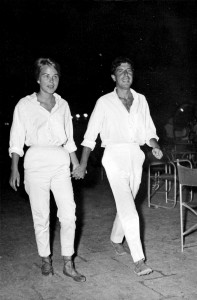Author Archives: Nora Lee Mandel
September 5, 2019 by Nora Lee Mandel
Does Leonard Cohen Embody Jewish Men’s Fantasy Fulfillment? An Exhibition and Documentary Film Provide Clues
By Nora Lee Mandel
When Canadian poet and singer/songwriter Leonard Cohen died November 7, 2016 at 82, eulogies reverberated with “mystical,” “mysterious,” and “celestial.” A new documentary, Marianne & Leonard: Words of Love (Roadside Attractions), and the exhibition Leonard Cohen: A Crack in Everything, up until September 8 at New York’s Jewish Museum, demonstrate that Cohen, like so many male artists of his and previous generations, fit a pattern of an archetypal Jewish men’s fantasy fulfillment. His muse, Norwegian Marianne Ihlen, was a blonde gentile goddess; a disparaging Yiddish word for the type is no longer PC.

Photo of Marianne Ihlen and Leonard Cohen from the film, “Marianne & Leonard: Words of Love.” Courtesy of Roadside Attractions.
Iconoclastic as he was, Cohen fit the pattern. Irving Berlin was inspired by fair-haired socialite Ellin Mackay to pen “Always” in the 1920s, and more love songs after they married. In the 1960s, Marilyn Monroe posthumously influenced her husband, Arthur Miller to write After the Fall. Diane Keaton was Woody Allen’s icon of golden non-Jewish women in Annie Hall and other 1970s films. This trope is so familiar that Albert Brooks satirized Sharon Stone as The Muse (1999) with flaxen tresses.
For the new Leonard Cohen film, director Nick Broomfield rediscovered home-movie-like footage from the 1960s by the late documentarian D.A. Pennebaker, where Marianne smiles, sails, and swims off the Aegean island of Hydra: “The sun bleached my hair, so in Greece I was very blonde…Leonard did the writing. I ran and did the shopping and brought food. I was his Greek muse, who sat at his feet. He was the creative one…I would say ‘I am an artist. Love is an art’. I was living.” After the luminescent Judy Collins initiated his performing career, Cohen’s road manager and record producer chuckle at how audiences seemed mostly women, particularly blondes, and that Cohen relayed them to his hotel room.
- No Comments
June 18, 2019 by Nora Lee Mandel
Barbara Rubin, Who Influenced Dylan, Ginsberg and Lou Reed, Gets Her Due
Barbara Rubin introduced Andy Warhol to the band the Velvet Underground, Allen Ginsberg to the Beatles, London to “Happenings,” Bob Dylan to Kabbalah, and female eroticism to film. So why don’t we know about her? In his feature length documentary “Barbara Rubin and the Exploding NY Underground,” director Chuck Smith reanimates the young Jewish woman who challenged the men of the 60s underground–an alt-culture was known for glorifying the phallus—with her vulva images, charisma, and artistic matchmaking.
- No Comments
March 31, 2016 by Nora Lee Mandel
What Two Frank New Documentaries Tell You About Women’s Lives
Two mature Jewish women artists premiered their latest and deepest plumbing of private lives at the Museum of Modern Art’s Doc Fortnight 2016: An International Festival of Nonfiction Film in NYC in February. Always intriguing, the 15th annual series showcases recent documentary films from around the world that, per the curatorial selection committee, push the boundaries “between contemporary art and nonfiction practices and reflect on new areas of documentary filmmaking.” Natalie Bookchin’s “Long Story Short” and Beth B’s bio-doc of her mother Ida, “Call Her Applebroog,” both attracted large appreciative audiences of family, colleagues, and fans.
Media artist Natalie Bookchin brought “Long Story Short,” a powerful project she had just finished editing after several years of filming—and listening closely to—diverse individuals at eight service organizations on the West Coast, including homeless shelters, food banks, adult literacy programs, and job training centers.

Bookchin gives intimate screen time to over 100 people usually hidden in plain sight—those struggling in poverty. Women, men, old, young, middle-aged, veterans, unemployed, single parent, homeless, ex-con, with HIV, most African-American and Latino (none apparently Jewish) in the Los Angeles and Oakland areas, they all face her laptop’s camera for video blogs. She takes the next, extended step from the brief Story Corps interviews heard on NPR and the captioned photographs of Brandon Stanton’s Humans of New York portraits.
Starting in the midst of the recession and last presidential election, she asked each participant: “What do you think people should know about you?” In their own words, her respondents express their feelings—many of them heartbreaking—on their childhoods and how they got to this difficult point. Encouraged to share what “I usually don’t tell people,” they all stress that “rich people don’t understand” how hard life is without a job, a phone, or an address. Women are especially frustrated that the certifications and degrees they’ve worked hard to achieve neither protect them from being laid off nor help them get any higher up the ladder. But they are proud of “being creative” with whatever they can afford, like improvising curtains in a shelter.
- No Comments
 Please wait...
Please wait...